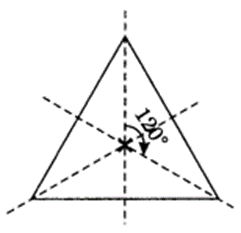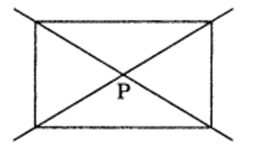Chapter 14 Symmetry Exercise 14.3
Question 1.
Name any two figures that have both line symmetry and rotational symmetry.
Solution:
English alphabet H and O both have line symmetry and rotational symmetry.
Question 2.
Draw, wherever possible, a rough sketch of
(i) a triangle with both line and rotational symmetries of order more than 1.
(ii) a triangle with only line symmetry and no rotational symmetry of order more than 1.
(iii) a quadrilateral with a rotational symmetry of order more than 1 but not a line symmetry.
(iv) a quadrilateral with line symmetry but not a rotational symmetry of order more than 1.
Solution:
(i) Equilateral triangle has 3 rotational symmetries.

(ii) Not possible.
(iii)

(iv) Not possible.
Question 3.
If a figure has two or more lines of symmetry, should it have rotational symmetry of order more than 1?
Solution:

Yes. The above figure has two lines of symmetry and also rotational symmetry of order 2.
Question 4.
Fill in the blanks:
Shape | Centre of rotation | Order of rotation | Angle of rotation |
Square | |||
Rectangle | |||
Rhombus | |||
Equilateral triangle | |||
Regular hexagon | |||
Circle | |||
Semicircle |
Solution:
Shape | Centre of rotation | Order of rotation | Angle of rotation |
Square | Point of intersection of diagonals | 4 | 90° |
Rectangle | Point of intersection of diagonals | 4 | 90° |
Rhombus | Point of intersection of diagonals | 4 | 90° |
Equilateral triangle | Point of intersection of medians | 3 | 120° |
Regular hexagon | Point of intersection of diagonals | 6 | 60° |
Circle | Centre | Infinite | Every angle |
Semicircle | Centre | 4 | 90° |
Question 5.
Name the quadrilaterals which have both line and rotational symmetry of order more than 1.
Solution:
Square, rectangles and rhombus are such quadrilateral which have both line and rotational symmetry.
Question 6.
After rotating by 60° about a centre, a figure looks exactly the same as its original position. At what other angles will this happen for the figure?
Solution:
If a figure is rotated through the angles 120°, 180°, 240°, 300° and 360°, it looks exactly the same.
Question 7.
Can we have a rotational symmetry of order more than 1 whose angle of rotation is
(i) 45°?
(ii) 17°?
Solution:
(i) Yes
(ii) No



